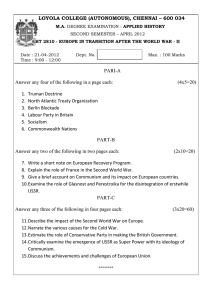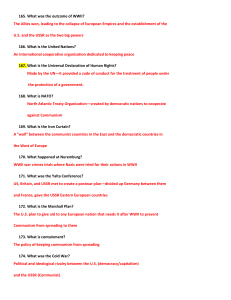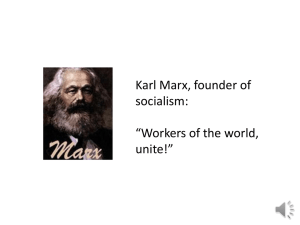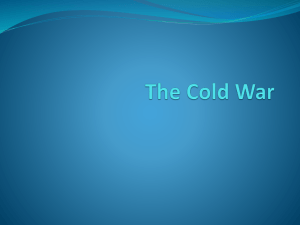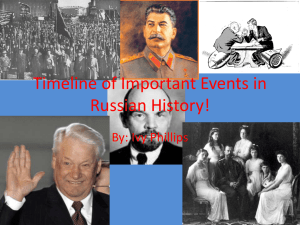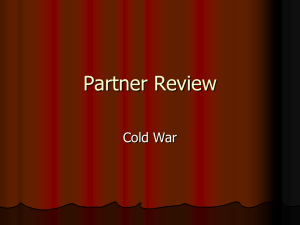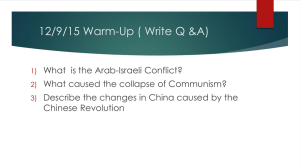Ch. 21 Reading Questions pg. 1035-1048
advertisement
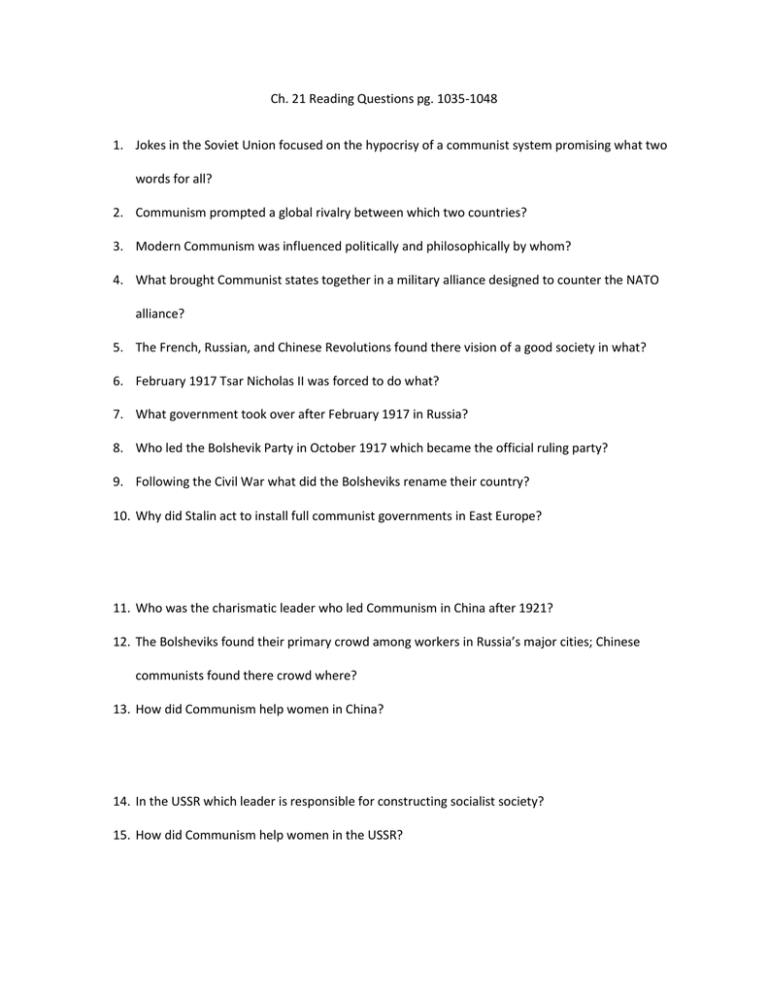
Ch. 21 Reading Questions pg. 1035-1048 1. Jokes in the Soviet Union focused on the hypocrisy of a communist system promising what two words for all? 2. Communism prompted a global rivalry between which two countries? 3. Modern Communism was influenced politically and philosophically by whom? 4. What brought Communist states together in a military alliance designed to counter the NATO alliance? 5. The French, Russian, and Chinese Revolutions found there vision of a good society in what? 6. February 1917 Tsar Nicholas II was forced to do what? 7. What government took over after February 1917 in Russia? 8. Who led the Bolshevik Party in October 1917 which became the official ruling party? 9. Following the Civil War what did the Bolsheviks rename their country? 10. Why did Stalin act to install full communist governments in East Europe? 11. Who was the charismatic leader who led Communism in China after 1921? 12. The Bolsheviks found their primary crowd among workers in Russia’s major cities; Chinese communists found there crowd where? 13. How did Communism help women in China? 14. In the USSR which leader is responsible for constructing socialist society? 15. How did Communism help women in the USSR? Ch. 21 Reading Questions pg. 1048-1057 1. Both the USSR and China defined what as a fundamental task of their Communist regimes? 2. How long were the model plans in Communism that involved state ownership of property, centralized planning, priorities on heavy industry, and massive mobilization? 3. Both the USSR and China experienced major and unprecedented what? 4. In China during 1958-1960 what promoted small scale industrialization in rural areas rather than focusing on large enterprises in the city? 5. In the 1960’s Mao Zedong launched what campaign to combat the capitalist tendencies he believed had penetrated the Communist Party? 6. How did the Cultural Revolution in China affect feminism? 7. How did the Soviets perceive nature? 8. Despite totalitarian tendencies, the communist societies of the USSR and China were laced with what? 9. In the USSR what is the Terror or Great Purge of the 1930’s? 10. What is the Gulag? 11. What is the heavily fortified border called between Eastern and Western Europe? 12. The extension of Communism into Asia, Korea and Vietnam did what to the Cold War? 13. What is considered the most haunting battle of the Cold War era? 14. What is considered the most novel and dangerous dimension of the Cold War? 15. Ch. 21 Reading Questions pg. 1048-1058 1. In the US sustaining the military effort was a flourishing ____________ and an increasing ________________ society. 2. The British pound was replaced by what currency as the most trusted international currency? 3. The successor to Stalin in the USSR when he died in 1953 was _____________? 4. Soviet forces actually ___________ their supposed allies of Hungary (1956-57) and Czechoslovakia (1968) to crush rebellion movements? 5. The two Communist giants the USSR and China found themselves sharply _________ to each other? 6. By the late 1960’s China on its own had developed nuclear weapons and was on the brink of war with ____________? 7. The death of ___________ in China led to the fall of Communism and the abandonment of his policies? 8. In Eastern Europe 1989 is known as “__________________” when popular movements toppled despised governments? 9. What happened in the Soviet Union Christmas Day 1991? ___________________ 10. What two failures general failures of the Communist experience led to its downfall? _______________ and _____________ 11. Following the death of Mao Zedong in 1976, Deng Xiaoping emerged as China’s “paramount leader” committed to ending the ___________ era? 12. Deng dramatic economic reforms put an end to the country’s system of ________________? 13. China’s burgeoning economy also generated massive ____________ among Chinese officials? 14. Although the party was willing to largely abandon communist economic policies, China was adamantly unwilling to relinquish its _____________________ or promote _______________ at the national level? 15. In 1987 Gorbachev launched an economic program called ______________? 16. Gorbachev’s policy of ______________ permitted unprecedented range of cultural and intellectual freedoms? 17. New freedoms in the USSR led to a _____________ movement of unofficial groups and new parties sprang to life? 18. In 1989 this fell in Berlin ________________? Answers Ch. 21 Reading Questions pg. 1035-1048 1. Equality and abundance 2. US and USSR 3. Karl Marx 4. Warsaw Pact 5. Modernizing the future 6. Abdicate the throne 7. Provisional Government 8. Lenin 9. USSR 10. US intervention with the Marshall Plan 11. Mao Zedong 12. Peasants 13. Gave women the right to vote, own property, outlawed arraigned marriages 14. Stalin 15. Full political equality, divorce legalized, pregnancy leave, women mobilized as workers Ch. 21 Reading Questions pg. 1048-1057 1. Industrialization 2. Five Year Plans 3. Economic Growth 4. The Great Leap Forward 5. Cultural Revolution 6. Rejected Feminism 7. Saw the environment as the enemy, environmental devastation 8. Conflict 9. Removing enemies who are considered traitors or linked to foreign imperialists 10. Harsh remote labor camps 11. Iron Curtain 12. Globalized the Cold War 13. Cuban Missile Crisis 14. Arms race in Nuclear Weapons 15. Ch. 21 Reading Questions pg. 1035-1048 1. Economy and Middle Class 2. US Dollar 3. Khrushchev 4. Invaded 5. Opposed 6. USSR 7. Mao Zedong 8. The Miracle Year 9. Soviet Union fell 10. Economic and Moral 11. Communist 12. Collectivized Farming 13. Corruption 14. Political Monopoly and Democracy 15. Perestroika 16. Glasnost 17. Democracy Movement 18. Berlin Wall
